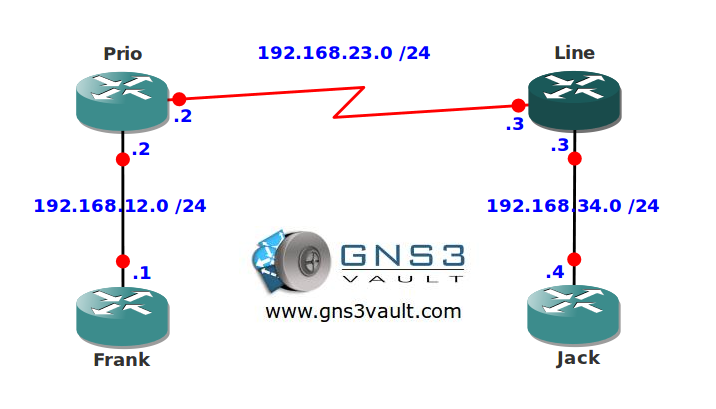Scenario:
You work for a large provider in India as a senior network engineer specialized in Quality of Service. All the customers of the service provider have an Ethernet connection which is capable of delivering speeds up to 10Mbps. The ISP has diffferent subscriptions and you need to enforce that customers only get what they are paying for…time to get in shape!
Goal:
- All IP addresses have been preconfigured for you.
- Configure router Line to shape all ICMP traffic towards router Jack to a peak rate of 256Kbps.
- Your bursts should be based on a 20ms interval.
IOS:
c3640-jk9s-mz.124-16.bin
Topology:

Video Solution:
Configuration Files
You need to register to download the GNS3 topology file. (Registration is free!)Once you are logged in you will find the configuration files right here.

Do you want your CCNA or CCNP Certificate?
The How to Master series helps you to understand complex topics like spanning-tree, VLANs, trunks, OSPF, EIGRP, BGP and more.
Written by René Molenaar - CCIE #41726


I really liked this MQC Class Based Peak Shaping lab Rene! However, I can’t figure out why I’m seeing Shaping Active = no when I enter show policy-map interface f1/0. Below is the config I entered:
Router: Line
config
class-map ICMP
match protocol ICMP
exit
policy-map SHAPE
class ICMP
shape peak 128000 2560 2560
exit
int f1/0
ip nbar protocol-discovery
service-policy output SHAPE
exit
exit
send traffic,
ping 192.168.34.4 r 100000 size 3000
Hello Renner!
I did not understand the calculation you did to arrive at the value of 2560. Could explain to me how I do this calculation?
Peak shaping means that Bc and Be are sent every interval. So, if we specify something like this:
shape peak 128000 2560 2560
We have specified the CIR as 128000, and we know Tc = Bc / CIR. In this case, Tc = 20 ms. However, 5120 bits can be sent every interval, which we computed to be 20 ms. With Tc of 20 ms, the shaper runs 50 times per second, so 50 * 5120 = 256000.
Expressed another way:
Tc = (Bc + Be) / PIR
0.02 = (2560 + 2560) / PIR
0.02 = 5120 / PIR
0.02 * PIR = 5120
PIR = 5120 / 0.02 = 256000
Line#sh policy-map int
Serial0/0
Service-policy output: POLICY
Class-map: ICMP (match-all)
5203 packets, 7202932 bytes
5 minute offered rate 0 bps, drop rate 0 bps
Match: protocol icmp
Traffic Shaping
Target/Average Byte Sustain Excess Interval Increment
Rate Limit bits/int bits/int (ms) (bytes)
256000/128000 640 2560 2560 20 640
Adapt Queue Packets Bytes Packets Bytes Shaping
Active Depth Delayed Delayed Active
– 1 33 27552 16 1984 yes
Class-map: class-default (match-any)
291 packets, 18616 bytes
5 minute offered rate 0 bps, drop rate 0 bps
Match: any